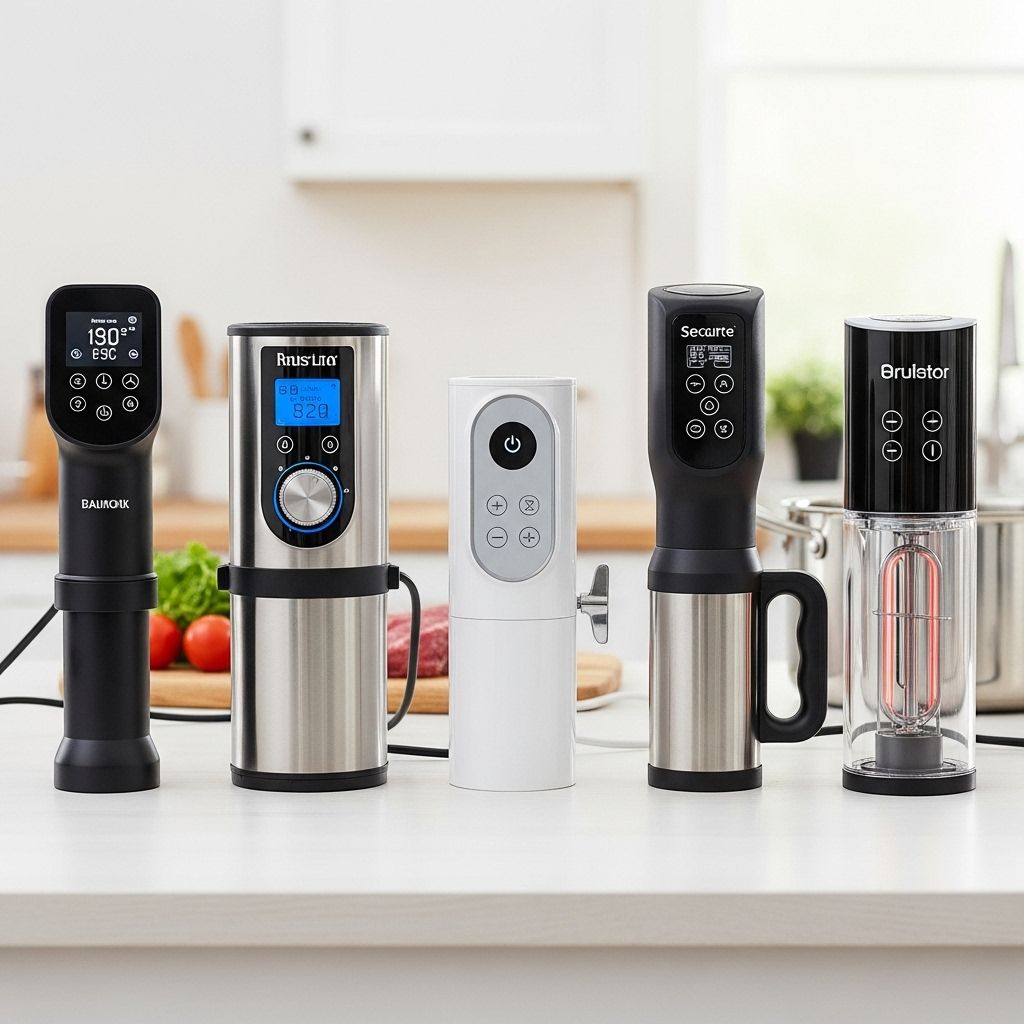Sous Vide Immersion Circulators: 5 Best Picks For Home Cooks
Precision water baths deliver consistently perfect meals without constant supervision.

The Best Sous Vide Immersion Circulators for Home Cooks
Precision and consistency have become mantras for modern home cooking, and few tools embody these ideals better than the sous vide immersion circulator. By maintaining a consistent water temperature over long periods, these devices allow even novice cooks to achieve perfectly cooked steaks, tender vegetables, and creamy eggs every time. The market for sous vide gadgets has expanded rapidly, bringing new brands and designs that promise reliability and convenience at every price point. This article delves into the top sous vide immersion circulators, examining how they measure up through hands-on testing, and aims to guide both budding and experienced sous vide enthusiasts in making an informed purchase.
Why Trust Our Sous Vide Immersion Circulator Recommendations?
Serious equipment reviews require more than brand familiarity or brief use—they demand methodical, side-by-side testing and a clear understanding of how sous vide circulators should perform in real kitchen environments. Our recommendations stem from extensive, hands-on testing, both in controlled settings and real-world scenarios. Each device is evaluated using rigorous benchmarks for speed, temperature accuracy, build quality, noise output, controls, water circulation, and safety features.
We assess each circulator not just for standalone performance but also for how it fits the needs of different users: budget shoppers, tech enthusiasts, frequent entertainers, and small-space cooks. Expert and home cook feedback supplement these findings to ensure recommendations reflect actual use cases, not just laboratory results.
What Is a Sous Vide Immersion Circulator?
Sous vide is a cooking method that involves vacuum-sealing food in a bag and then cooking it to a very precise temperature in a water bath, typically for an extended time. The immersion circulator is the essential device in this process. It heats the water to the set temperature and circulates it around the food to ensure even, consistent cooking. Compared to older methods (such as stovetop or oven), sous vide immersion circulators:
- Provide exact temperature control, reducing the risk of overcooking.
- Enable hands-off, stress-free cooking for meats, vegetables, eggs, and more.
- Support prep-ahead meal planning with easy scalability—from single plates to dinner parties.
How We Test Sous Vide Immersion Circulators
Our testing regime aims to surface differences that matter in daily use. Key steps include:
- Warming Speed: Measuring how quickly each circulator heats a given volume of water to a specific temperature.
- Temperature Stability: Using a calibrated thermometer to gauge each device’s ability to maintain a precise target temperature under typical load.
- Circulation Power: Evaluating water flow to ensure even temperature distribution (essential when cooking multiple bags or in larger vessels).
- Noise Level: Observing operational sound, particularly for cooks who want a quiet kitchen.
- Ease of Use: Rating the intuitiveness of controls, displays, and app connectivity (where available).
- Build and Safety: Inspecting durability, water resistance, and auto shut-off features.
- Form Factor: Judging device size, weight, and clamp design for fit in various kitchens and containers.
Devices are used to prepare a range of sous vide staples—from steak and chicken to custards and vegetables. Results are cross-checked for consistency and repeatability, ensuring recommendations reflect true everyday performance.
Top Picks: The Best Sous Vide Immersion Circulators for 2025
| Model | Best For | Highlights | Estimated Price (USD) |
|---|---|---|---|
| Anova Precision Cooker | Versatility & App Control | Reliable build, accurate temperature, robust app features | $150 – $200 |
| Breville Joule | Small Kitchens & Tech Lovers | Compact design, powerful motor, superb app, magnetic base | $200 – $250 |
| Instant Accu Slim | Best Value | No-frills design, simple controls, exceptional value | $75 – $100 |
| Inkbird WiFi Sous Vide | Budget + Connectivity | Sturdy, reliable, app-enabled, basic interface | $80 – $100 |
| KitchenBoss G320 | Quiet Operation | Silent running, sturdy clamp, simple controls | $100 – $120 |
Anova Precision Cooker
Consistently at the top of sous vide circles, the Anova Precision Cooker stands out for its combination of accurate heating, user-friendly controls, and robust smartphone connectivity. The Anova app includes guided recipes, remote monitoring, and easy firmware updates. Its clamp fits well on various containers, and its water circulation ensures even heat, whether you’re cooking eggs for brunch or a whole rack of ribs. For tech-minded or frequent home chefs, Anova remains a reassuringly solid choice.
Pros:
- Highly reliable app control with consistent connection.
- Good heating rate for most household volumes.
- Excellent temperature accuracy.
Cons:
- Some users find it bulkier than competitors.
- Higher price compared to entry-level models.
Breville Joule
The Breville Joule is revered for its compact profile—just 11 inches tall—which makes it easy to store in shallow drawers or small kitchens. Despite its small size, the Joule delivers water-heating power on par with larger models. Its magnetic base can stick to steel pots directly—no clamp required. Joule’s app interface remains a gold standard for usability, offering visual doneness guides and custom notifications. However, it’s designed to operate solely through the companion app: there are no onboard controls.
- Remarkably compact for easy storage.
- Powerful heating and rapid water circulation.
- Intuitive, recipe-driven app experience.
Cons:
- No built-in manual controls—all functions are through the app.
- Pricier than entry-level units.
Instant Accu Slim Sous Vide Immersion Circulator
For those wanting streamlined design and strong performance at a budget-friendly price, the Instant Accu Slim stands out. It is lauded for heating water quickly, maintaining temperature to a degree of precision that matches more expensive competitors, and offering straightforward, tactile controls. There’s no Bluetooth or WiFi connectivity—but many home cooks will prefer the simplicity. It’s compact enough for most storage drawers.
- Very affordable with consistent performance.
- Simple dial interface—easy to operate with wet hands.
- Lightweight and durable for frequent use.
Cons:
- Lacks app connectivity and advanced features.
- Shorter cord than some rivals—placement may be an issue in certain kitchens.
Inkbird WiFi Sous Vide Machine
Inkbird’s WiFi sous vide offers a smart solution for buyers who want connectivity without the expense of premium models. It can be remotely controlled via smartphone and has stable temperature control, with enough power for family-sized meals. The physical controls are straightforward, and the display is clear. Build quality is solid for its price.
- App connectivity on a budget.
- Sturdy construction and reliable heating element.
- Easy to clean and simple clamp mechanism.
Cons:
- App less polished than bigger brands.
- Some users report WiFi setup can take time.
KitchenBoss G320
If a quiet kitchen is essential, the KitchenBoss G320 is targeted squarely at you. It runs almost silently, ensuring you hear only the gentle bubble of the water bath, not an intrusive pump or fan. Controls are simple and the clamp grips securely to various containers. While app features are minimal, its core performance is impressive for medium-sized family meals.
- Very quiet operation—almost silent in use.
- Good temperature stability and decent water movement.
Cons:
- Limited digital features and no smartphone control.
- Control panel is basic compared to others.
How to Choose the Right Sous Vide Immersion Circulator
When selecting a sous vide immersion circulator, consider these core criteria:
- Temperature Accuracy: Look for precision within 0.1°F or 0.1°C for best results.
- Heating Power: Higher wattage models (800–1100W) heat large volumes faster, but lower wattage models suffice for single portions.
- Controls: Do you prefer direct manual input, or app-connected operation? Consider your comfort with smartphone tech.
- Build and Clamp: Ensure the device can attach securely to your typical pots or water containers, and is easy to store.
- Noise Output: If kitchen noise is a priority, scan for reviews mentioning silent or quiet performance.
- Budget: Reliable performance now starts at $75; advanced features and design can cost $150 and above.
Sous Vide vs. Traditional Cooking Methods
| Aspect | Sous Vide | Traditional Cooking |
|---|---|---|
| Temperature Control | Precise to 0.1°F; minimal risk of overcooking | Varies significantly; easier to overcook or dry out food |
| Consistency | Results are repeatable, dish after dish | Highly dependent on timing and attention |
| Hands-On Time | Mostly hands-off, low monitoring required | Often needs close attention, stirring/turning |
| Texture and Tenderness | Exceptional; can achieve restaurant-quality doneness | Varies and can be inconsistent |
| Cooking Time | Longer, but with perfect results | Typically faster, but less forgiving |
Tips for Getting the Most from Your Sous Vide Circulator
- Use Proper Bags: Invest in food-safe, vacuum-sealed or zip-top freezer bags to avoid water leakage.
- Don’t Overcrowd: Ensure water flows freely around each bag for even cooking.
- Sear for Finish: After sous vide, give proteins a quick sear in a hot pan or with a torch for flavor and texture.
- Keep Water Level in Check: Most circulators have a minimum fill line; check occasionally and top off as needed, especially for long cooks.
- Clean Regularly: Rinse the immersion circulator thoroughly after each use to prevent buildup and ensure longevity.
Frequently Asked Questions
Q: Can I use any pot or container with an immersion circulator?
A: Nearly any heatproof vessel will work, as long as it’s deep enough for the water to circulate and maintain the minimum fill line. Many brands offer custom sous vide containers, but basic stockpots are suitable for most home applications.
Q: Are sous vide immersion circulators energy efficient?
A: Yes, most models are designed to be energy efficient, using less electricity than an oven or stovetop for prolonged cooks. Actual consumption varies by water volume, cook time, and device wattage.
Q: Do I need a vacuum sealer for sous vide cooking?
A: While a vacuum sealer offers the best seal, heavy-duty zip-top freezer bags with most air pressed out work well for most foods. For liquids or marinated items, a vacuum sealer is more effective at preventing leakage.
Q: How do I clean my immersion circulator?
A: Unplug, allow to cool, and then remove the lower metal sheath (if possible, consult your instruction manual). Rinse with warm water and use a soft cloth to clean. Avoid submerging electrical components.
Q: What’s the main benefit of cooking with sous vide?
A: The main benefit is precision. Sous vide allows you to consistently achieve your desired doneness, from tender beef short ribs to perfectly cooked eggs, with almost no risk of drying out or overcooking.
Final Thoughts
The sous vide immersion circulator has gone from chef’s secret to mainstream kitchen staple, making restaurant-quality results accessible at home. Whether your priority is precise temperature, app integration, quiet operation, or affordability, this year’s best-tested models offer something for every cook. With proper technique and the right circulator, sous vide can transform weekday dinners and special occasion feasts alike—one perfectly cooked meal at a time.
References
- https://boards.straightdope.com/t/beginners-report-for-sous-vide-cooking/995749?page=3
- https://www.amazingfoodmadeeasy.com/info/modernist-cooking-blog/more/anova-precision-cooker-immersion-circulator-detailed-review
- https://www.kitchenknifeforums.com/threads/serious-eats-tests-the-anova-sansaire-and-nomiku-sous-vide-circulators.16010/
Read full bio of Anjali Sayee












